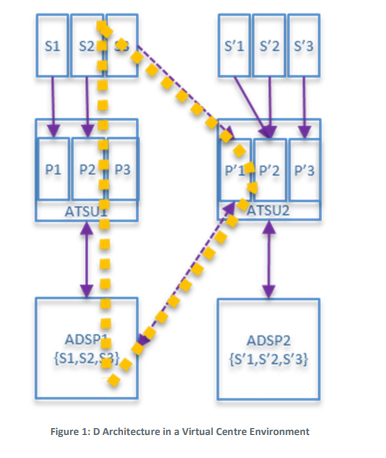D is for 'dependable': ATM data service provider (ADSP) connecting to several air traffic service units (ATSU)
Introduction
The virtual centre concept refers to the decoupling of air traffic management (ATM) data services, such as flight data, radar, and weather information, from the air traffic service unit (ATSU). The aim of the concept is, on one hand, to enable greater flexibility when it comes to organising air traffic control operations and, on the other hand, to support a more resilient ATM ecosystem.
Two key dimensions of the virtual centre concept are the ability to delegate control of an area of airspace between air traffic service units and the establishment of ATM data service providers (ADSPs) to manage real-time data processing for one or more air traffic service units.
Three supporting architectures are available to facilitate that delegation: D, Y and U, each responding to different virtual centre configurations and operational use cases.
The ‘D’ architecture is applied on a delegation between two air traffic units, each with its own ADSP and using virtual centre interoperability to remotely connect controller working positions from the receiving air traffic unit to the ADSP of the delegating unit, without affecting the respective areas of responsibility.
About the Solution
In terms of use cases, this architecture is particularly useful in contingency scenarios, in night/fixed time scenarios and demand capacity scenarios with static sector configuration of the ATSUs.
The Solution enables to an air traffic service unit, which is supported by a specific ADSP, to delegate the air traffic services to another unit served by a different ADSP. This is achieved by allowing controller working positions of the receiving unit to subscribe to the delegating ADSP services, thus keeping the air traffic unit’s areas of responsibility unchanged.
The ‘D’ architecture can be deployed with the use of a standard virtual centre services or with the use of proprietary interfaces common to both units, being the use of the standard virtual centre services optional.
The standardisation of the services would bring benefits on cost efficiency and scalability. The standardisation requires aligning the functionality and edits to the human machine interfaces, to make them as similar as possible for both the delegating and the receiving units. The standardised approach would therefore ease the handover process of traffic between air traffic service units and increase safety.
The D architecture solution has reached a TRL4 maturity level during SESAR 2020 activities. SESAR research and Digital Sky Demonstrators (DSD) projects include plans to progress towards higher maturity levels for this architecture and the associated use cases.

Benefits
• Increased flexibility and operational efficiency
• Improved cost efficiency
• Increased resilience in terms of ATM service provision
• More efficient handover of traffic
• Increased safety due to enhanced visibility of HMIs between ATSUs
